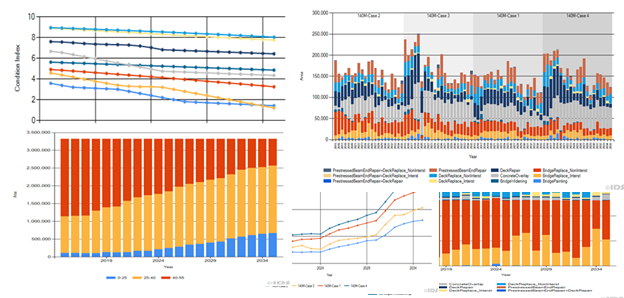

Overview
Client: Iowa Department of Transportation (Iowa DOT)
Location: Ames, Iowa, USA
Project: Multi-Objective Optimization for Long-Term Network-Level Preservation Planning of Bridges in Iowa
IDS was commissioned by Iowa DOT to develop an optimized risk-based 20-year preservation plan for the state-owned bridge inventory. IDS used its flagship NBI Optimizer® software to generate optimal preservation plans under a wide range of scenarios, and to analyze the trade-offs among these scenarios to provide evidence-based recommendations to Iowa DOT engineers.
Challenge
Iowa DOT, like other DOTs across the US, is facing unprecedented challenges due to ageing structures, increasing demands and expectations for levels of service, and mounting construction costs. Iowa DOT has been working to implement risk-based approaches and develop long-term preservation plans to ensure sustainability, reliability, and efficiency of state-owned bridges. Iowa DOT required a solution that ensures the generation of optimized project lists over a 20-year planning horizon under a wide range of scenarios. It also required that the generated plans meet a range of policy constraints and align with preservation practices in the department.
Solution
This project involved the use of NBI Optimizer® to develop multi-variate inductive deterioration models for bridge decks, superstructure, and substructure elements and to build a risk-based prioritization scheme based on Iowa DOT Priority Ranking method. The deterioration models were developed based on historical NBI data and considered a range of variables such as age, traffic volume, design load, and deck type, etc. A comprehensive database of preservation methods commonly used in Iowa DOT was created. The preservation methods database included a wide range of technologies including bridge replacement, deck replacement, deck overlay, deck repair, bridge widening, and prestressed beam end repair. The database also implemented a set of constraints and formulae for calculating costs and benefits, as well as to determine applicability constraints of each preservation method according to Iowa DOT policies and work practices.
Over fifteen preservation planning scenarios were investigated to provide a comprehensive understanding of the impact of various budget profiles on system-wide condition/risk levels and to evaluate budget requirements for desired condition/risk targets. Iowa DOT engineers defined scenario parameters including budget profile, varying annual levels of condition/risk levels, budget splitting among preservation methods, average annual inflation rate, etc. For each scenario, NBI Optimizer® generated optimal and feasible project lists that satisfied all defined criteria and policy constraints. The impact of each scenario on system-wide condition and risk measures were also assessed, including determining expected structurally deficient bridges under each scenario. The software was also used to analyze trade-offs between funding levels and system-wide performance and risk levels based on the results obtained from various scenarios. The generated optimal preservation plans were evaluated by Iowa DOT engineers and compared to the current 5-year plan of the department. NBI Optimizer® SaaS cloud-based services have been used by Iowa DOT staff to analyze planning results, in addition to accessing NBI analytics functions, detailed reports, and interactive maps and dashboards.
The generated 20-year risk-based optimal preservation plans will enable the development of defensible and optimized preservation plans that maximize the return on investment, and to justify planning decisions using objective system-level measures and procedures that are aligned with Iowa DOT’s policies and requirements.
